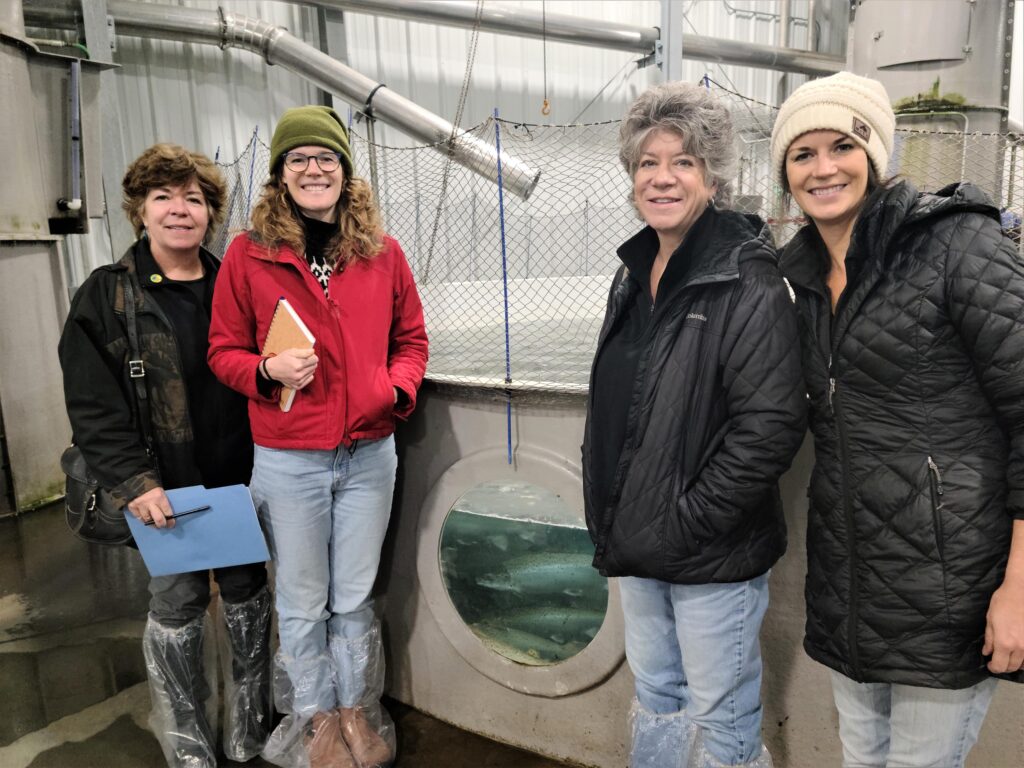
Sea Grant staff learned more about aquaponics from a tour of the Superior Fresh facility in Wisconsin. Here they stand in front of some Atlantic salmon being readied for market. From left to right: Sharon Moen, Jenna Mertz, Marie Zhuikov, Emma Hauser. Image credit: Kyle Woolever, Superior Fresh.
Superior Fresh knows what it takes to raise fish on land and plants in water.
The aquaponics business, located on 800 acres of rolling woodland and prairie in Hixton, Wisconsin, has been raising Atlantic salmon and growing salad greens in its indoor facilities since 2017. The business reports it’s the largest of its kind in the world, producing 1.5 million pounds of salmon per year plus organic-certified salad greens.
It’s a big operation, and one I had the chance to tour in late October with a small group from Wisconsin Sea Grant that included Sharon Moen, food-fish outreach coordinator; Emma Hauser, aquaculture outreach and education specialist with Wisconsin Sea Grant and the UW-Stevens Point Northern Aquaculture Demonstration Facility (NADF); and Marie Zhuikov, fellow science communicator.
It was good opportunity for me, a newcomer to Sea Grant and the world of aquaculture, to learn more about fish farming and Superior Fresh’s recirculating aquaculture system (RAS). Wisconsin Sea Grant supports aquaculture research, including Hauser’s work in outreach, education and workforce development at NADF. Many of the interns NADF hosts go on to work at Superior Fresh—a fact evidenced by all the friendly faces Hauser recognized during our tour.
After pulling plastic coverings over our shoes (which required some artful hopping on my part), we followed Kyle Woolever, director of operations and a UW-Stevens Point graduate, as he showed us around the facility, which recently experienced a 60,000-square-foot expansion. He explained that the building houses half a million fish, all of which are reared in and transferred between tanks based on fish size and stage of lifecycle. Salmon are raised from egg to market size—which is about 10 pounds in just over two years.
All those fish, of course, require a constant flow of water. Gesturing toward the big tanks, Woolever talked about the water footprint of the facility.
“Two small wells are raising all of what you’re going to see on 50 [gallons per minute],” he said. (Residential wells pump between five and 10 gallons per minute.)
How does Superior Fresh raise salmon using relatively little water? The answer is their RAS, which includes high-tech equipment and monitoring to effectively clean and recycle the water throughout the facility. This water is also used in the greenhouse, where leafy greens further remove the nutrients they need to grow. The water then returns to the fish, and the cycle restarts.
Superior Fresh captures all wastewater from the production system by irrigating over 50 acres of native grasses and alfalfa, while operating with zero wastewater discharge. The grasses and alfalfa are cut and baled several times annually and are used by local farmers for cattle bedding. The business also uses other regenerative farming practices, such as creating a soil amendment from digested fish manure, which can be injected into fields before planting.
After touring the aquaculture facility, Woolever led us to the greenhouse, where the thrum of churning water faded to the quiet sound of plants photosynthesizing. It’s here where the nutrient-rich fish water fuels the growth of Superior Fresh’s organic salad greens.
Entering the greenhouse was an arresting sight. Rows of white rafts filled with lettuce, kale, mustard, arugula and sorrel floated in long tanks of water. Sam Heward, greenhouse manager, explained how plants make a linear journey from one side of “the pond” to the other. Baby greens spend about three weeks on the water before harvest.
The greenhouse is warm and bright and, we joke, the perfect place to be in winter. And it’s not just plants and humans that enjoy the summer-like conditions.
“It’s a perfect environment for plants,” said Heward, “which makes it also a perfect environment for [plant] diseases.”
The team is vigilant about watching for root disease and will change varieties or flush the tank if problems arise.
By the end of the tour, it was clear that Superior Fresh is working so that Atlantic salmon don’t have to be airfreighted across oceans from Chile or northern Europe—they can come from your local community—and greens don’t have to be grown thousands of miles away in sun-soaked states. In other words, they’re successfully forging another way to eat Wisconsin fish (with a side of salad).


